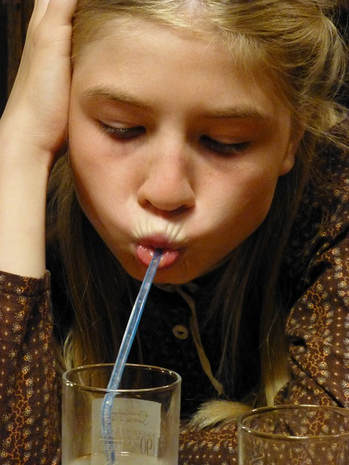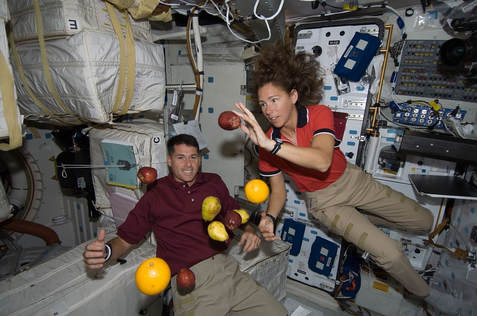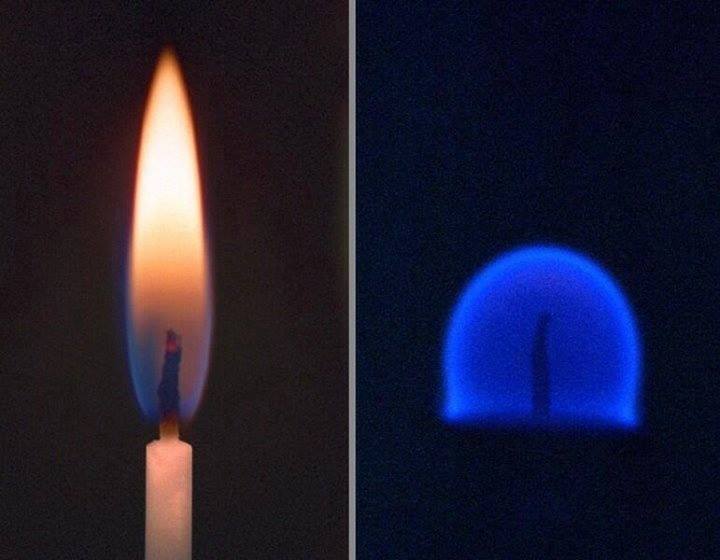|
I wrote a post regarding how our experience can mislead us into assuming certain things to be true. I came across an even more remarkable example that caught me by surprise, and I want to share it with you, not just because it is very interesting, but also because many people get the explanation wrong. We all know that air bubbles released underwater rise to the top because air is less dense than water, right? We all know that hot air rises and cold air sinks because hot air is less dense than cold air, right? When things are exposed to a medium that is denser than they are, these things tend to rise and are said to be buoyant. This is our everyday experience, this is common sense. In what possible situation could this not be true? On Earth we take buoyancy for granted, but we seldom think about the role that gravity and its opposing forces play in determining buoyancy. Let’s imagine a sealed plastic cylinder with water, standing on the ground. If we release a bubble at the bottom of the cylinder, the bubble will float up as expected. We say this happens because the bubble is made up of air which is less dense than water, but we need to understand better why this happens in more detail. Under the influence of gravity, the water inside the cylinder is pulled down towards the Earth and exerts a pressure against the walls of the cylinder. In turn the walls of the cylinder exert a pressure against the water that counteracts the gravitational pull. This pressure that opposes gravity is not equal along the length of the cylinder. An object at the bottom of the cylinder will experience the full weight (pull of gravity) of the whole column of water inside the cylinder and will experience a counter pressure of equal magnitude, whereas an object halfway up the cylinder will only experience half of the weight of the column of water and will experience half of the counter pressure. So there is what is called a pressure gradient along the length of the cylinder, with bottom being maximum pressure and top being minimum pressure. If you have ever swum to the bottom of the deep end of a pool, the feeling you got in your eardrum is due to the greater pressure at the bottom. So an object like a cork or a water bubble rises, not just because it is less dense, but because the pressure at its bottom end is greater than the pressure at its top. It is the pressure differential across the top-down axis of the object that makes it rise, and (this is key) what makes possible this pressure differential is the simultaneous application of both the force of gravity and the forces that oppose gravity (the pushing of the wall of the cylinder against the water). Now imagine we place the cylinder high up in the air on a platform with a trapdoor. Gravity pulls on the cylinder and the platform generates a force that opposes the pull of gravity. This force is transmitted to the cylinder and counters the pull of gravity on the water. Now imagine we release a bubble at the bottom of the cylinder as before, but this time we open the trapdoor making the cylinder fall. What will the bubble do? Will it rise to the top of the cylinder as before? In the video below you can see an attempt at answering this question here on Earth. The authors of the video released bubbles at the bottom of a sealed container and dropped it. The experiment is not perfect as there are issues with respect to the friction generated by the air on the container that antagonize to a certain extent the force of gravity, but you can clearly see at 2 minutes and 45 second into the video that some bubbles at the bottom of the container cease to rise (cease to be buoyant) when the container is dropped. However, the video ascribes this effect to a cessation of gravity, which is not true. A better way to perform this experiment is to release an air bubble inside a mass of water in a free-falling object like the international space station (ISS). As you can see in the video below, at 1 minute and 33 seconds, the air bubbles indeed don’t “rise” inside the blob of water. This effect is also observed when air, instead of water, is involved. Consider a lit candle here on Earth. As the candle burns, it heats the air in the vicinity of the wick. This air expands, becomes less dense, and is pushed up by the surrounding cooler denser air (much in the same way as the water molecules in the cylinder push against the air bubble). The pressure the cooler air exerts on the warm air at the bottom of the candle flame is higher than at the top of the flame, thus the warm air rises. This brings a stream of cool air, and therefore more oxygen, into the bottom part of the candle to repeat the cycle and maintain the flame: a process that is called buoyant convection and which gives candle flames their characteristic elongated shape. But this process only works because cool air accumulates on the surface of the Earth pushing against warm air and opposing gravity (much like the walls of the cylinder push against the water inside it). In a free-falling object, such as the international space station, there is no force to oppose gravity, and the cool air does not push against the warm air, which means that buoyant convection cannot feed oxygen to the flame. Because of this, the candle relies on simple diffusion (movement of a substance down its concentration gradient) of oxygen from the surroundings to maintain the flame, a process that is much slower. As a result, any candles lit in the International Space Station will display a round shape, burn much less vigorously, and tend to snuff themselves out. The important thing to understand (despite the use of words like “zero gravity” or “microgravity” in many of the videos and posts that endeavor to explain this effect) is that gravity is not impaired and doesn’t cease to exist. Think about it. The relevant gravitational force involved in these experiments is that of the Earth. For gravity within this context to cease to exist, the Earth would have to disappear! The reason buoyancy ceases in the International Space Station in space, or is impaired in the free falling cylinder here on Earth, is that gravity is not antagonized in these conditions. Buoyancy requires both gravity and the presence of an opposing force. In a free falling object gravity is unopposed; it is the only force acting upon the object. Therefore, because there is no force to push against gravity, the pressure gradient required to generate buoyancy is not produced. So you see, three things are required for an object to float freely: 1) Gravity, 2) A force that opposes gravity, and 3) the object having a lower density than the medium surrounding it. Remember, it takes 3 to buoyango.* *Well, I think it’s clever. Flame on Earth and Zero G by 2il org used here under an Attribution 2.0 Generic (CC BY 2.0) license.
0 Comments
We often frame the way we react to and interpret reality based on what we experience. This perfectly reasonable approach, however, is not always accurate, and science can explain why. I will present some examples today and try not to sound too pedantic while doing it! Consider sunrises and sunsets. For millennia we have basked in the splendor of the spectacle of the sun rising in the morning and setting in the afternoon. That is our experience, right? The sun goes up and then down. How many poems and paintings and songs have been inspired by sunrises and sunsets? How many metaphors? The mere sight of the orb of the sun clearing the horizon or sinking below it has had a profound influence on the psyche of our species. The problem here is, of course, that the sun doesn’t “rise” or “set”, it is the Earth that turns! “Sunrises” and “sunsets” are just an illusion created by the fact that we are living on a rotating planet.  When drinking a beverage through a straw many people will claim to be “sucking” the liquid. If pressed to explain how the liquid gets from the container to their mouths, they will probable add that they create a vacuum inside the straw with their mouths and the vacuum “sucks” the liquid. This is not true. You have several hundred miles of air on top of you which generates a pressure at sea level of 14.7 pounds per square inch. This tremendous pressure is applied to everything including the drink and the air inside the straw. When you “suck” on the straw, your lungs expand creating a low pressure area inside them which is transmitted to the cavity inside the straw, and air moves from high pressure areas to low pressure areas. But in this case, the beverage is between the inside of the straw and the atmosphere. Thus the atmosphere pushes the liquid up the straw and into your mouth. The same happens with a vacuum cleaner. The motor creates a low pressure zone inside the machine by blowing air out, and the atmosphere pushes the air towards the inside. Sucking a liquid with a straw or operating a vacuum cleaner inside a room where the air has been removed (i.e. where the effect of the atmospheric pressure has been eliminated) would not work. Vacuums don’t suck. It is the atmosphere that pushes. How many people have asked others to shut a window or a door because they are letting the cold in (winter) or out (summer)? Here “cold” is being treated as an entity, and that is the problem. Cold doesn’t exist! The real entity is heat energy. Heat has a physical correlate (molecular vibrations) and can be measured (temperature is the measure of the heat content of something). At absolute zero (−459.67 °F), molecular motion ceases, there is no heat, and things can’t get any colder. What we perceive to be colder is something with less heat, and what we perceive to be warmer (or less cold) is something with more heat. Much in the same way that darkness is the absence of light and not a real entity in itself; cold is the absence of heat.  Let’s do one last one. We have seen videos of astronauts in the International Space Station (ISS) moving around their craft. Most people describe the astronauts as floating. Strictly speaking, this is not accurate, as for something to float it has to have a density lower than the medium surrounding it (think a balloon filled with helium released into the atmosphere). The astronauts pirouetting about the ISS are not less dense than the air that surrounds them, therefore they are not floating. At this point most people would clarify that the astronauts just appear to be floating. That is a fair reply, but when pressed as to why this is the case, many will answer that it is because there is no gravity in space. This is again not true. To understand why, imagine the following: you jump from a high diving board. During the few seconds before you hit the water are you floating? No, you are falling. Now imagine that as soon as your feet leave the diving board a room materializes around you, and this room has a camera in a corner. If I were to check the footage of the camera for the few seconds before you and the room hit the water, I would see you seemingly “floating” inside the room. But you are not floating, you are falling. Similarly, the astronauts inside the ISS are falling towards the Earth because they and the station are being pulled by gravity towards our planet. So why doesn’t the ISS crash and burn? This is because the station is moving at just the right speed to match the curvature of the Earth. As the ISS falls, the Earth curves, so the station and the astronauts inside it are always falling, but they never hit the ground. Gravity is alive and well in space. These are some cases of how our experience does not accurately describe the actual physical phenomena in the world that surrounds us. Can you think of any other examples? Please leave a comment, and let me know. Images from Pixabay used under a CC0 Creative Commons license. |
Details
Categories
All
Archives
June 2024
|

 RSS Feed
RSS Feed